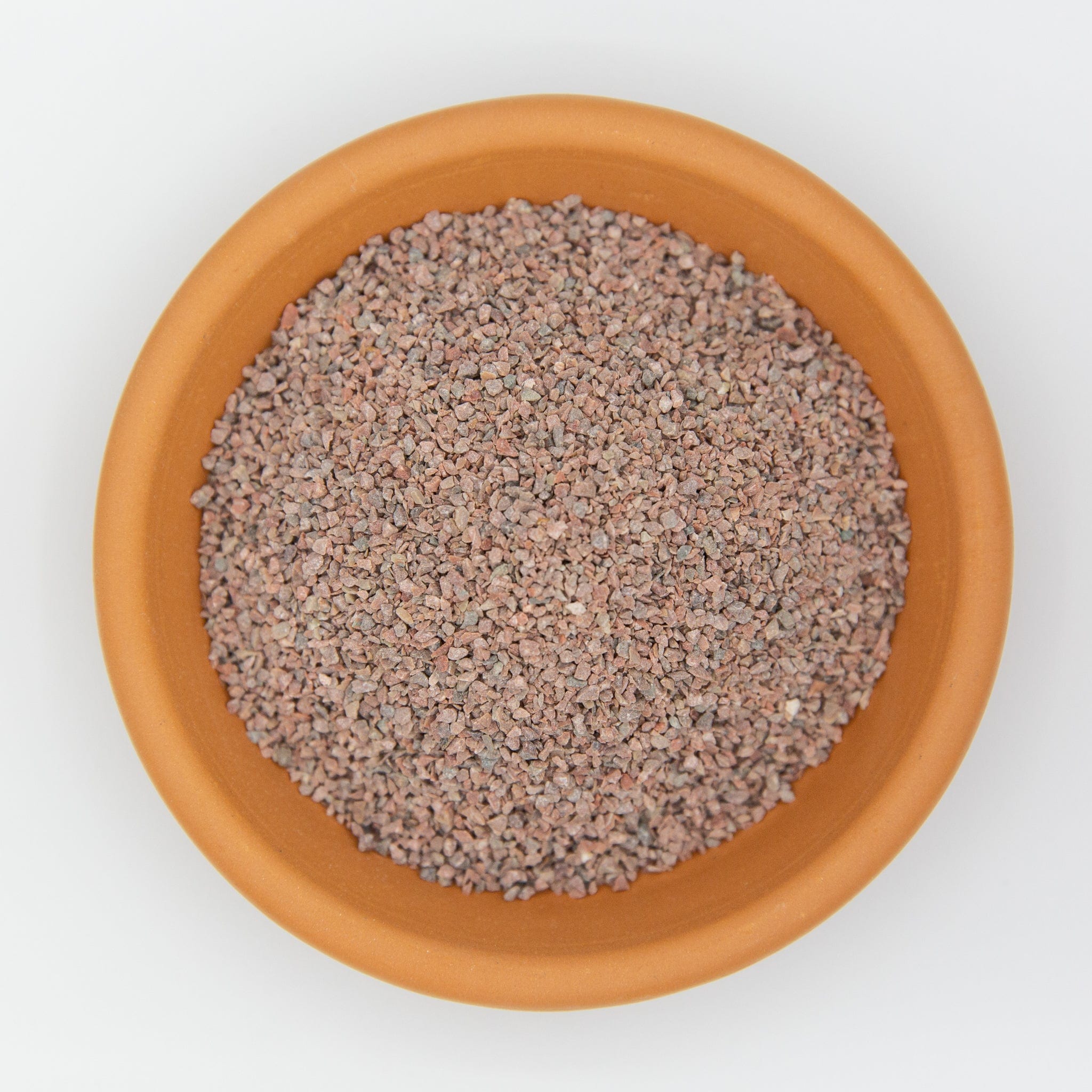Zeolite 4–6mm is a premium, mineral-based soil amendment designed to improve drainage, enhance nutrient retention, and maintain long-term soil structure without degradation.
This larger grade is ideal for plants with more robust root systems and is a favorite among bonsai, succulent, and cactus growers seeking a dependable, long-lasting aeration component.
Thanks to its high cation-exchange capacity (CEC), zeolite acts like a slow-release sponge, absorbing excess nutrients and minerals and gradually making them available to roots and beneficial microbes. Perfect for use in containers, no-till beds, or as part of your custom soil mix.
Features
-
Coarse 4–6mm grade for improved air space and drainage
-
All-natural mineral that won’t break down over time
-
Boosts nutrient retention and minimizes leaching
-
Enhances microbial activity in the root zone
-
Supports moisture balance for healthier plant growth
-
Ideal for use in cactus, succulents, bonsai, and organic garden beds
Why You Should Buy
This zeolite grade provides superior drainage and nutrient buffering in one clean solution. It improves the aeration of dense mixes while holding just the right amount of moisture for plants prone to root rot. Whether you're building a mineral-rich soil blend for bonsai artistry or enhancing a succulent mix for better growth, Zeolite 4–6mm ensures consistent, long-term benefits that outperform traditional organic aerators.
FAQs
What exactly is Zeolite 4–6mm?
A hard, naturally occurring mineral (clinoptilolite) sieved to a chunky 4–6 mm grade. It boosts drainage, holds nutrients (high CEC), and doesn’t break down—perfect for cactus, succulents and bonsai mixes.
Why pick the 4–6 mm size over finer zeolite?
Bigger grains create more air space and faster drainage for woody, rot-prone plants. Finer grades (.7–2 mm) hold a bit more water and suit seedlings or water-hungry mixes.
Will zeolite change my soil pH?
No. Clinoptilolite is essentially pH-neutral, so it won’t swing your mix acidic or alkaline.
How much should I mix into potting media?
General pots: 10–30% by volume.
Bonsai/cactus/succulents: 30–60% (often with pumice/lava).
Heavy, peaty bagged soils: start at 25% and adjust after a watering cycle.
How much for garden beds?
500 g–2 kg per m² worked into the top 10–15 cm. Go lighter for sandy soils, heavier for sticky clays.
Do I need to rinse Zeolite before use?
A quick rinse is smart to remove dust/fines—especially for indoor plants and bonsai where you want clean pores and tidy top dressing.
Does zeolite improve drainage or water holding? Which is it?
Both. The granules keep the mix open (better drainage/oxygen), while the internal pores hold water and nutrients that roots can actually access.
Can Zeolite help reduce fertiliser use?
Yes. Zeolite grabs excess nutrients and releases them slowly, cutting leaching and making each feed go further.
Is Zeolite reusable/long-lasting?
Yep. It’s a rock—doesn’t decompose. You can sift and reuse when repotting; just discard any grains that have turned to mud (rare) or are clogged with salts.
Will Zeolite stop root rot?
It won’t cure bad watering, but it massively reduces the risk by increasing airflow and avoiding soggy zones where pathogens thrive.
What’s the best mix recipe for succulents and cactus?
A no-nonsense starter: 40% zeolite (4–6 mm), 40% pumice, 20% quality composted material. For ultra-arid species, push minerals to 80–90%.
Good bonsai blend using this grade?
40% zeolite 4–6 mm, 40% pumice, 20% lava (or similar scoria). For deciduous species that like a touch more moisture, swap 10% minerals for bark.
Can I use Zeolite as a top dressing?
Yes—4–6 mm looks clean, dries quickly on top (discourages fungus gnats), and keeps collars airy.
Is Zeolite safe for organic gardens and microbes?
Absolutely. Zeolite supports beneficial microbes by holding both moisture and nutrients right where biology lives.
Does Zeolite compact over time like some gravels or bark?
No. It stays structurally stable for years. That’s one of the big wins vs organic aerators that collapse as they break down.
How does Zeolite compare to perlite or pumice?
Perlite: super light, great aeration, floats/blows away, no CEC.
Pumice: airy and porous with some CEC.
Zeolite: heavier (plants won’t fall over), very high CEC, and excellent structure. Many mixes use pumice + zeolite together.
Will the heavier weight be a problem in pots?
Only if you’re hanging baskets or moving big planters often. The extra mass actually stabilises tall or top-heavy plants.
Any color variations or “pink vs white” differences?
Color varies with trace minerals; performance is what matters. Clinoptilolite is the key spec—this product is the good stuff.
Is Zeolite dusty?
There can be a little mineral dust from transport. A quick rinse or pre-wet settles it.
Can I blend Zeolite into compost or worm farms?
Yes. A handful per layer in compost can reduce odours and nutrient loss. In worm farms, use sparingly—just a light sprinkle to buffer ammonia and hold nutrients.
Will Zeolite affect my fertiliser program or pH-up/pH-down routine?
It won’t fight your pH adjustments, and it will make fertilisers more efficient. You may find you can reduce feeding frequency/strength—watch plant response and dial in.
Can I use Zeolite in hydro or aquaponics?
As an inert media in flood-and-drain beds—yes, the 4–6 mm size works. For recirculating aquarium filters, use purpose-packed media bags; note zeolite captures ammonium and can become saturated.
Can Zeolite be “recharged” like aquarium zeolite?
That’s an aquarium-specific trick (salt soaks). For horticulture, there’s no need—keep growing and reuse at repot.
Is Zeolite safe around pets and kids?
It’s an inert mineral. Don’t inhale dust, don’t ingest it, and you’re fine. Wear a simple mask if you’re decanting lots of dry product.
Will Zeolite help with salty bore/town water?
It can buffer some ammonium and reduce leaching losses, but it’s not a desalination filter. If your water is dodgy, treat the water at the source first.
What plants benefit most?
All drought-prone or rot-sensitive plants—aloes, echeveria, cacti, conifers, olives, figs, natives, and most bonsai species.
How often should I repot when using zeolite-heavy mixes?
Repot on plant schedule (root growth), not because the media fails. Expect longer intervals because the structure stays open.
Any tips for clay soils?
Blend 1–2 kg per m² into the top layer with compost/gypsum. Zeolite improves structure and nutrient holding while gypsum breaks clay bonds.
Can I sterilise or clean it between reuses?
You can rinse thoroughly and sun-dry. If you suspect pathogens, soak in 3% hydrogen peroxide solution, rinse, dry, and reuse.
What sizes and pack options are available?
5 L, 10 L, and 25 kg bag. Use 5–10 L for small projects and top-ups; 25 kg is best value for mix-making and beds.
How far does a bag go?
As a rough guide:
• 5 L mixes ~10–20 L of potting soil at 25–50% zeolite
• 10 L mixes ~20–40 L of potting soil
• 25 kg bag comfortably treats several large planters or ~12–50 m² of garden bed at 0.5–2 kg/m²
Any gotchas?
Don’t treat it like magic and drown your plants. Zeolite helps, but overwatering still kills. Start at moderate ratios, observe, then tweak.
Bottom line—what problem does Zeolite solve for growers?
Soggy mixes, nutrient waste, and collapsing structure. Zeolite 4–6 mm keeps roots breathing, fertiliser working, and mixes stable for the long haul. Perfect fit for Dr Greenthumbs’ mineral-forward, low-BS approach to potting media.


